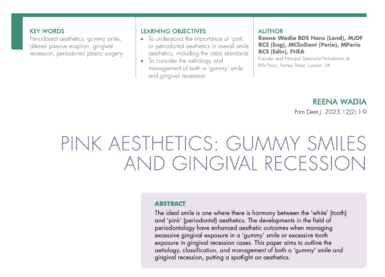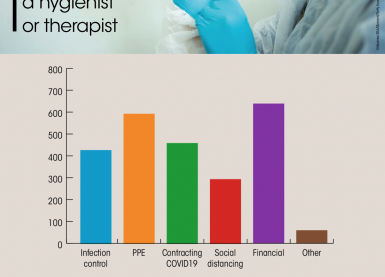Home/Articles
/ General Dental /
Reena’s Notes: 16 Tips and Tricks for Successful Endodontic Outcomes in General Practice with Dr Vishal Jasani
June 29, 2021

- SENSIBILITY TESTING – Use Endofrost rather than Ethyl Chloride as it is colder (-40/50 degrees rather than -4) and less expensive. Always use both Endofrost and the electric pulp tester to confirm negative results.
- When trying to identify a CRACKED TOOTH – use a tooth sleuth which will allow pressure to be concentrated on one cusp of a suspected tooth. Test one cusp at a time and the pain should be on release if there is a crack. If you use a narrow matrix band tightened around the tooth and repeat the test, a lack of pain may mean there is a crack.
- MAGNIFICATION AND ILLUMINATION make a huge difference so try and invest in a pair of loupes with a light.
- ISOLATION – the use of a rubber dam is essential in endodontics. Always use floss tied to both ends of the clamp just in case it breaks. When selecting a clamp, you need to ensure there are at least 4 points of engagement around the tooth. Clamps with ridged edges can help. Once flossed, put the clamp on the tooth first to see if it will engage and make sure it doesn’t rock prior to putting on the rubber sheet. If you want to isolate 2 anterior teeth, split your butterfly clamp in half and use each piece for one tooth. The benefits of using a clamp over widgets, is that it pushes the rubber sheet out of the way. Oroseal (and liquid dam) can help to prevent salivary ingress.
- ACCESS to remove the entire roof of the pulp chamber rather than find canals. If you do that correctly then within those confines, you will be able to successfully locate all canal orifices. The roof of the pulp chamber is commonly incompletely removed so check for overhangs of the pulp using your probe. It is important to get this stage right to prevent other stages from being compromised. Also, pulp horns harbour bacteria and if they are incompletely removed this may influence the success of your treatment.
- For 97% of mandibular teeth and 98% of maxillary teeth, the roof of the pulp chamber is at the level of the CEJ (Deutsch et al 2004). This can provide a helpful external guide when ACCESSing i.e. if you are beyond the CEJ, you are likely to be in the wrong place. Use a cusp as a reference point and mark the level of the CEJ on your bur.
- When ACCESSing, especially when you are refining, it can be helpful to use piezoelectric ultrasonics as you can cut and see at the same time (rather than using a bulky handpiece). Tungsten Carbide tips are recommended.
- You are aiming for straight line ACCESS. When using a Gates Glidden under any lips of dentine, brush upwards and outwards against and you will open up orifice.
- CANAL POSITION – the colour of the dentine in the pulp chamber is different to the dentine of the bulk of the tooth. The canals are located at the corner of the floor and the wall of the pulp chamber. Search for canals using a probe at 45 degrees rather than straight down. The position of the canals either lie on, or are equidistant from a central line bisecting the tooth and multiple canals lie on a perpendicular to this central line.
- APEX LOCATORS are a great tool that let you know if you are in the canal or outside the canal (or if you have perforated). Your working length is 0.5 mm short of the apex locator reading. Apex locators need to be used correctly to prevent false readings. Essentially they work by completing a circuit so be aware of anything that may cause a short circuit and give a false reading e.g. existing metal restoration, liquid within pulp chamber contacting the outside of the tooth coronally and inflammatory exudate through the apex into the canal. Solutions: remove all restorations and rebuild in a non-conductive material, dry canals, seal temp and retake measurements once period of disinfection has been undertaken, use larger file which will contact the wall of the root canal, check the batteries are fully charged and always take a radiograph.
- Use sodium hypochlorite as your main IRRIGANT. Make sure it is of a known concentration (at least 1%). Whilst IRRIGATING there are a number of things you can do to reduce the chance of a Sodium hypochlorite accident: use a bent needle tip 2 mm short of the shortest canal to start off with, use your finger (rather than your thumb) to minimise pressure, create a gentle steady drip rather than a constant flow and rather than locking the needle in the canal you need to keep it moving. If you do this, the irrigant won’t flow more than 1 mm beyond the end of the needle. You can also use a 30G needle tip, which requires as ISO size 30 hand file preparation rather than size 40 file. Use a surgical suction tip as this will allow better visualisation and better aspiration.
- Whilst PREPARING, make sure you continually clean the flutes of your rotary/hand files. Clogged up flutes dramatically reduce efficiency. You can clean the flutes by poking it into your endo sponge/any other sensible method.
- EDTA can be a helpful lubricant but should only be used in selected cases. It is better to use the liquid rather than the paste as dentine chips tend to get suspended in the paste, turning it into a cement and impeding progress in the canal. EDTA plus a surfactant may be antibacterial.
- GP – We can MEASURE accurately if we cut, or mark rather than bend. Flatten a cusp slightly if the tooth is going to be crowned to get a definitive reference point. GP can bend at the tip when placing it into the canal, if this keeps happening try using endofrost spray to stiffen the tip. CUTTING GP can be tricky – you can use a dry piezo ultrasonic, ball ended bur with a fast handpiece, induction heater or buy a GP cutter (available from QED for around £150). Remember, the ideal position to cut back the GP to prevent discoloration labially is 2 mm below the CEJ. Isopropyl alcohol is good to help clean cement and GP.
- When OBTURATING, always twist your finger spreader before taking it out to prevent the GP points from advancing coronally. Also ensure your GP tip(s) have not folded apically as this can also lead to a short obturation.
- TEMPORISATION is important to ensure a good seal between appointments. Often we use a huge piece of cotton pledget and this leads to the loss of our temporary. The size of the cotton pledget should be small – a tiny ball over each orifice gives you the whole height of the pulp chamber for your temporary restoration. It is fine to use Cavit (as long as you have more than 4 mm height) but also overlay it with GIC to give you a better seal.
Learn more by reading some of our other articles here.



